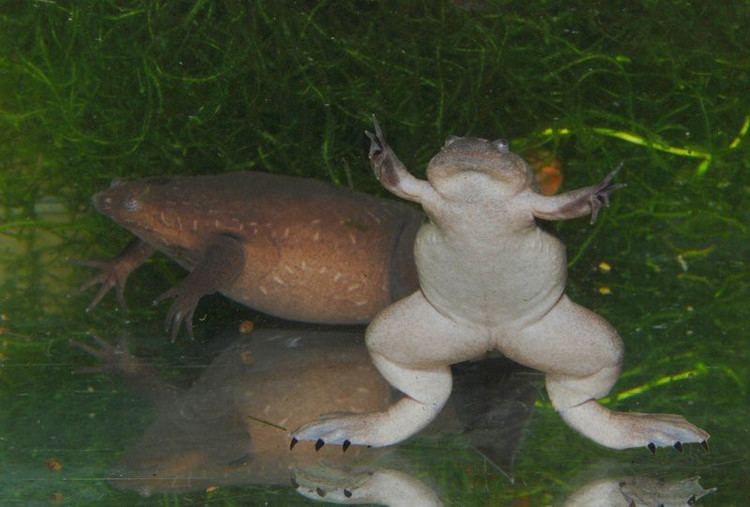Order Anura Higher classification Silurana | Phylum Chordata Rank Species | |
 | ||
Similar African clawed frog, Xenopus, Frog, Vertebrate, Amphibians | ||
The western clawed frog (Xenopus tropicalis) is a species of frog in the Pipidae family, also known as tropical clawed frog. It is the only species in the Xenopus genus to have a diploid genome. Its genome has been sequenced, making it a significant model organism for genetics that complements the related species Xenopus laevis (the African clawed frog), a widely used vertebrate model for developmental biology. X. tropicalis also has a number of advantages over X. laevis in research, such as a much shorter generation time (<5 months), smaller size (4–6 cm (1.6–2.4 in) body length), and a larger number of eggs per spawn.
Contents
It is found in Benin, Burkina Faso, Cameroon, Ivory Coast, Equatorial Guinea, Gambia, Ghana, Guinea, Guinea-Bissau, Liberia, Nigeria, Senegal, Sierra Leone, Togo, and possibly Mali. Its natural habitats are subtropical or tropical moist lowland forests, moist savanna, rivers, intermittent rivers, swamps, freshwater lakes, intermittent freshwater lakes, freshwater marshes, intermittent freshwater marshes, rural gardens, heavily degraded former forests, water storage areas, ponds, aquaculture ponds, and canals and ditches.
Description
The western clawed frog is a medium-sized species with a somewhat flattened body and a snout-vent length of 28 to 55 mm (1.1 to 2.2 in), females being larger than males. The eyes are bulging and situated high on the head and there is a short tentacle just below each eye. A row of unpigmented dermal tubercles runs along the flank from just behind the eye, and are thought to represent a lateral line organ. The limbs are short and plump, and the fully webbed feet have horny claws. The skin is finely granular. The dorsal surface varies from pale to dark brown and has small grey and black spots. The ventral surface is dull white or yellowish with some dark mottling.
Distribution and habitat
The western clawed frog is an aquatic species and is found in the West African rainforest belt with a range stretching from Senegal to Cameroon and eastern Zaire. It is generally considered a forest-dwelling species and inhabits slow-moving streams, but it is also found in pools and temporary ponds in the northern Guinea and Sudan savannas.
Biology
In the dry season, this frog lives in shallow streams and hides under tree roots, under flat stones, or in holes in the riverbank. It feeds primarily on earthworms, insect larvae and tadpoles. When the rainy season starts it migrates across the forest floor at night to find temporary pools. Spawning may take place in large pools with much vegetation, but tadpoles are also sometimes found in muddy pools with no vegetation. Single eggs may be attached to plants or they may float. The tadpoles have broad mouths and no jaws, but have long tentacles on their upper lips. The ventral fins of their tails are broader than the dorsal ones. Their body colour is generally orange and the tail transparent but in darker locations the tail may be blackish. The tadpoles feed by filtering zooplankton from the water. In large water bodies, they may form dense swarms. Metamorphosis takes place when the tadpoles measure about 5 cm (2 in) in length.
Status
The IUCN lists the western clawed frog as "Least Concern" because it has a wide distribution and is an adaptable species living in a range of habitats, and the population trend seems to be steady.
Use as a genetic model system
See also Xenopus - Model organism for biomedical researchXenopus embryos and eggs are a popular model system for a wide range of biomedical research. This animal is widely used because of its powerful combination of experimental tractability and close evolutionary relationship with humans, at least compared to many model organisms.
Unlike its sister species X. laevis, X. tropicalis is diploid and has a short generation time, facilitating genetic studies. The complete genome of X. tropicalis has been sequenced
Xenbase is the Model Organism Database (MOD) for both Xenopus laevis and Xenopus tropicalis.
